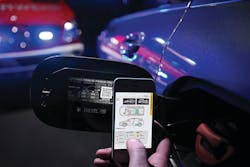University of Extrication: Mercedes-Benz Responder Safety Initiative
SUBJECT: Mercedes-Benz Responder Safety Initiative
TOPIC: Mercedes-Benz QR Code Program
OBJECTIVE: Become familiar with the Mercedes-Benz QR Code program and the Rescue Card information provided through the system
TASK: Given a Mercedes-Benz vehicle with QR codes present to inspect, the rescue team shall utilize a smartphone device to read a QR code and display the Rescue Card responder information
A new safety initiative has been launched by Mercedes-Benz that is important for responders to be aware of. All Mercedes-Benz vehicles manufactured since December 2013 are equipped with two items that are designed specifically to assist fire, medical and rescue personnel at the scene of a vehicle incident. Using QR code technology, one white-and-black QR code sticker is now located inside the fuel filler door on these new production vehicles. In addition, a second QR code sticker is affixed to the front side of the B-pillar on the opposite side of the vehicle from the fuel door. The opposite side locations are so that a responder arriving at an incident involving a QR code-equipped Mercedes-Benz vehicle has the greatest chance of accessing at least one of the QR codes quickly.
Using their own smartphone or tablet device equipped with a camera along with having any of the various free QR code reader apps already installed, the responder can scan either sticker and have their device display the vehicle’s Rescue Card, a one-page information sheet with important details about the safety features on the specific vehicle involved.
Mercedes-Benz has provided Rescue Card information for all of their vehicles for many years. With this new QR code initiative, the responder on scene has direct access to the specific Rescue Card that describes that vehicle. The Rescue Cards utilize line drawings of the vehicle; top view and side view. The Rescue Card locates important items such as the batteries, airbags, stored-gas inflators and locations of reinforced ultra-high-strength steels. On hybrid vehicles, the Rescue Card locates the high-voltage components that responders should be aware of at the scene. From personal experience using an existing software program, the Crash Recovery System, to obtain similar detailed data about vehicles at an incident scene, this author knows it is a tremendous help to find out where to look for one or more 12-volt batteries; engine compartment, truck, under a seat, etc.
There are several important notes that must be understood by responders if this Mercedes-Benz QR code system is going to be of value. At the scene, one of the two QR code stickers would have to be accessible. With one inside the fuel filler door and the second one on the opposite side of the vehicle, it is very likely that at least one QR code sticker will be able to be accessed. The fuel filler door is lockable, but automatically unlocks when the vehicle is involved in a collision. To use the QR code system also means that responders will have to get in the habit of opening the fuel filler door on vehicles; something that we rarely do now, but will have to integrate into our standard protocols for QR code vehicles.
Also, to make the system work, a smartphone or tablet device with its built-in camera would have to be available to the responders. This device would have to already have a QR code reader app installed. Responders will also need adequate light thrown onto the sticker’s location so the QR code can be scanned by the smartphone or tablet.
Once the responder scans the QR code, their device must then also have Internet access in order to pull down the appropriate Rescue Card. With the initial version of this program, the Mercedes-Benz Rescue Card data is not stored on the phone or tablet; it is retrieved through the online access to the Mercedes-Benz website. A future app for responders, planned to be available by the end of June 2014, will allow the rescue card to be read even without an Internet connection.
Owners of any Mercedes-Benz vehicle back to 1990 can have two QR code stickers installed at their local dealership. In addition, Mercedes-Benz has waived its right to a patent application so the technology will be available for other vehicle manufacturers. At least one U.S.-based automaker is already planning to utilize this system for their brand of vehicles.
An additional resource that should be of interest to rescue and extrication personnel is a rescue guideline document provided at no cost by Mercedes-Benz. The 187-page illustrated document specifically describes a huge number of vehicle rescue tasks that can be accomplished on Mercedes-Benz vehicles. The full-color guideline was produced in Germany and includes images depicting German fire service personnel completing each of the extrication tasks. Tools used throughout the guideline include hydraulic-powered rescue systems, electric tools, as well as basic hand tools. The free document, “Guidelines for Rescue Services Passenger Cars,” can be downloaded at: http://www.evsafetytraining.org/~/media/Electric%20Vehicle/MercededBenz_AMG_McLaren_Maybach_Smart_Guidelines_for_Rescue_Services_ERG.pdf n
TASK: Given a Mercedes-Benz vehicle with QR codes present to inspect, the rescue team shall utilize a smartphone device to read a QR code and display the Rescue Card responder information
Ron Moore presents “University of Extrication Training: Airbag Update 2014” at Firehouse Expo 2014.
About the Author
Ron Moore
RON MOORE, who is a Firehouse contributing editor, recently retired as a division chief with the McKinney, TX, Fire Department and now serves with Prosper, TX, Fire Rescue. He self-published the Vehicle Rescue 1-2-3 training manual and serves as the forum moderator for the extrication section of Firehouse.com . Moore can be contacted directly at [email protected].

